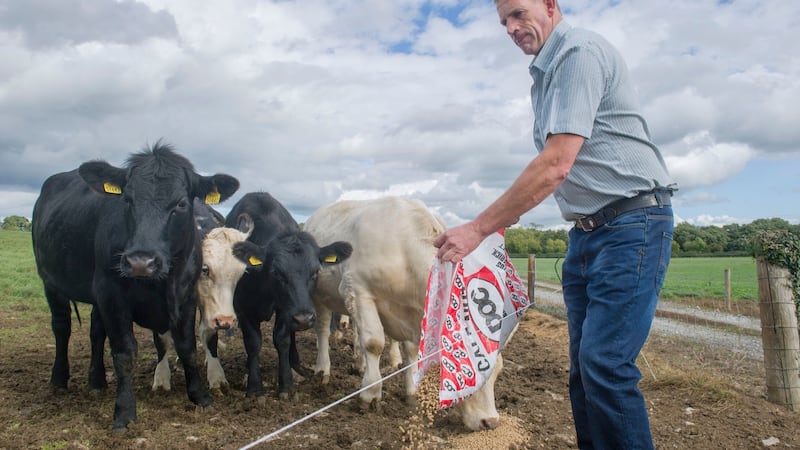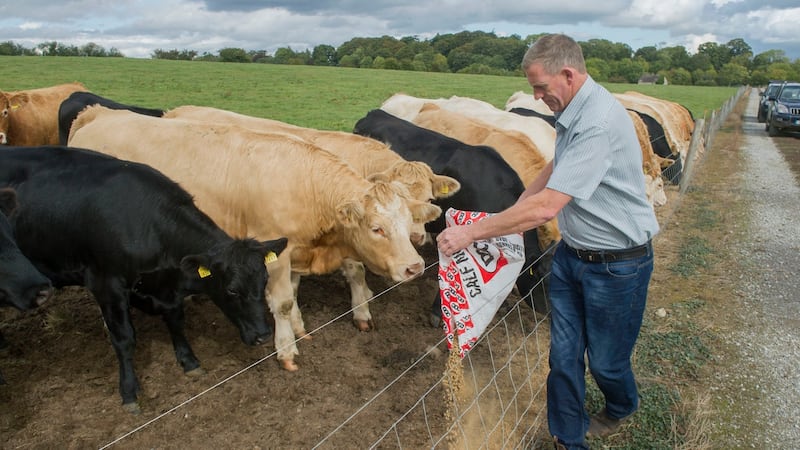“We had a very long winter last year and with ground conditions were so wet, cows couldn’t graze so farmers were feeding silage much earlier and depleting their reserves and there’s been such poor growth this summer that a lot of farmers are going to be facing into another tough winter.”
John Coughlan (53) from Buttevant in north Cork is expansive mood as he explains the challenges facing many farmers this winter. Farmers have endured a year of exceptional weather conditions which look set to have serious consequences for our dairy and beef sectors.
Coughlan is Munster regional chairman of the Irish Farmers' Association and has been farming independently since he was 20. He is the sixth generation of his family to farm the 240 acre holding at Ballyellis in Buttevant where he milks 110 cows and sends around 100 beef cattle for slaughter every year.
He chronicles the experience of many livestock farmers, the backbone of Irish agriculture, over the past 12 months or so. And this shared experience is sure to be a hot topic at the National Ploughing Championships this week.
“You could say last winter ran from September through to May. It was that long and animals were indoors rather than out grazing so a lot of farmers ended up with depleted fodder reserves. Everything was eaten so fellows were no longer carrying over reserves as they often would do.
“You then had a short period of growth at the end of May when you had sunshine, heat and moisture in the ground. But then the ground started to dry up and you didn’t have the same growth, which meant farmers had to feed some of their May silage over the course of the summer.
“Some areas got such a roasting that fellows never got a second cut of silage and they won’t get a chance to make any extra feed now because any grass that grows now will be eaten between now and November 1st when they will be looking to put animals back inside as the ground gets wet.”
Coughlan acknowledges the problem is not universal across the entire country. The western seaboard from Donegal to Kerry escaped the record temperatures that scorched the east coast.
"If you drew a line from Dublin to Limerick and then from Limerick to Bandon, anything east of that got badly caught. There was no second cut of silage and the first cuts were being eaten during the summer. So it's a double whammy for farmers in much of Munster and south Leinster. "


The consequence will be primarily financial. Coughlan reckons affected farmers have ended up feeding a tonne of meal per animal already this year compared to 300-400kg usually. This resulted in a spend of €200-€300 extra per cow compared to previous years.
The importance of the livestock sector, both dairy and beef, within the agricultural sector is huge. It dwarfs all other parts, as highlighted by Dr Kevin Hanrahan, head of the Rural Economy and Development Programme in farm advisory body Teagasc.
Dr Hanrahan says the total value of goods output in agriculture is €8 billion with dairy accounting for almost €2.6 billion and beef almost €2.4 billion. Pigs account for €500 million, sheep and horses €300 million each, poultry €160 million and cereals a further €230 million.
Only 15,500 or so of the 135,000 farms in the country are dairy farms, but the income on these farms is much higher than those engaged in others areas. The 2017 Teagasc National Farm Survey showed the average dairy farm income was €86,000, compared to a farm average of €31,000.
Dr Hanrahan estimates that farm income on dairy farms rose by as much as 65 per cent in 2017 as farmers increased their milk output while prices were very high and costs low, resulting in high margins per litre.
“One of the things that has characterised the diary output value in the last 10 years has been an upward trend, particularly since the abolition of quotas in 2015. But with that upward trend, there has also been increased volatility,” says Dr Hanrahan.
Milk prices are lower and costs are higher
“In 2016, the value of milk output was €1.8 million. But it jumped to €2.6 billion last year. It’s likely to drop back again significantly this year because while the total quality of milk delivered this year is only marginally behind where it was last year, milk prices are lower and costs are higher.”
Dr Hanrahan acknowledges that there will be regional variations in the grass growing ability of land. But the overall pattern this year is one where farmers will have to buy in fodder to feed their animals.
“Those increased costs mean that the margin per litre is going to be significantly lower this year. Costs are going to be higher and the price they get for milk is going to be lower than 2017. And the average income for dairy farmers could be back as much as 20 per cent this year,” he says.
Irish farmers will have to resort to imported fodder again this winter as happened earlier this year and in 2013 when co-ops bought in fodder from the UK. The key difference this time is that the UK and other countries have also had poor growth, according to Coughlan.
"There's a big demand for fodder all across northern Europe – Sweden, Finland, Holland, Norway, Germany are all in trouble and the UK is badly affected too so there is big demand which is driving up the price. Anything coming in is from Spain and Italy, with transport costing €350 a tonne."
While Irish tillage farmers have been badly hit, particularly in the southeast, some, such as James Hegarty from Whitechurch in Co Cork, are confident that closer co-operation between tillage and livestock farmers can be mutually beneficial.
Hegarty has some 1,100 acres under a variety of crops – winter oilseed rape, winter barley, winter wheat, spring barley, spring oats and forage maize – and yields are down.He concedes the situation is likely to be even worse for farmers in places like Wexford, Kilkenny and Waterford which were even harder hit by the dry summer. But he believes the model he operates, whereby he sells directly to livestock farmers, could prove beneficial for both sectors.
“We grow about 300 acres of forage maize under plastic for livestock farmers. The plastic acted to conserve moisture and it worked very well – all the deals are done in advance and it’s sold in the spring before it’s sown and we take stage payments for it,” he says.
There are huge opportunities for both
"We've also put in a lot of Westerwold which is a fast growing hybrid grass as part of a Department of Agriculture incentivised scheme. And I have a list as long as my arm of farmers who want to buy it; we supply about 80 farmers from Listowel and Tralee in Kerry over to Clashmore in Waterford.
“I really do believe if tillage farmers and dairy farmers and livestock farmers work closely together to form partnerships and got into contract arrangements to grow fodder crops rather than hammering each other over trying to rent land, there are huge opportunities for both.”
Aside from fodder, the other main challenge facing Irish farmers over the next 12 months is Brexit and its impact. Coughlan says that while farmers are still in the dark as to its precise impact, he has no doubt it poses a huge challenge.
“Nobody knows what way Brexit is going to go. But given the UK takes 40 per cent of our beef and is a good market for our cheddar cheese on the dairy side, we need to protect it. A fall in the value of sterling is going to make us less competitive in that market so there’s a lot of uncertainty.
"Any issue relating to the Border either within Ireland, or between Ireland and the UK, is also going to cause a huge problem for us and not just farmers and suppliers in the Border area but the whole country as we import and export a lot to and from Europe through the UK."
Add in the issue of Common Agricultural Policy reform – which looks set to play out in 2019 into the mix along with the aforementioned fodder crisis or at least a more expensive fodder situation and Brexit – and the year ahead looks like being a challenging time for Irish farmers.







